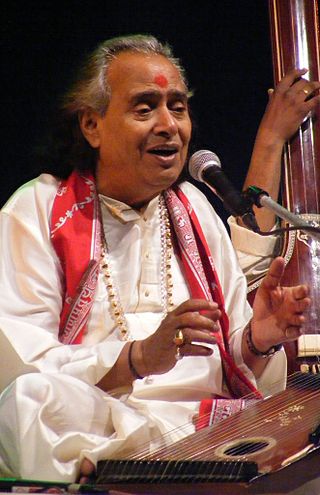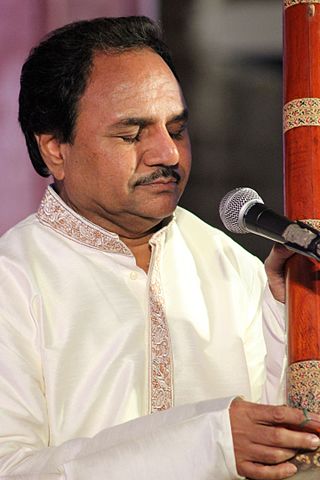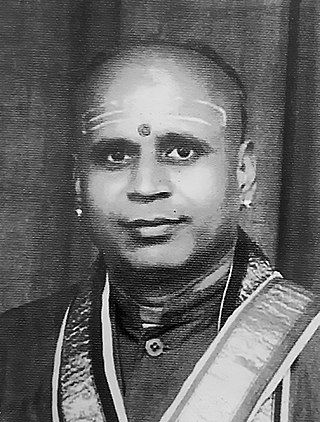
Bhajan refers to any devotional song with a religious theme or spiritual ideas, specifically among Dharmic religions, in any language. The term bhajanam means reverence and originates from the root word bhaj, which means to revere, as in 'Bhaja Govindam' . The term bhajana also means sharing.

Aatmaram Dubey, known as Tulsidas, was a Vaishnava (Ramanandi) Hindu saint and poet, renowned for his devotion to the deity Rama. He wrote several popular works in Sanskrit, Awadhi, and Braj Bhasha, but is best known as the author of the Hanuman Chalisa and of the epic Ramcharitmanas, a retelling of the Sanskrit Ramayana, based on Rama's life, in the vernacular Awadhi language.

Swami Purushottamananda was a monk of the Ramakrishna Mission. He was a prolific writer and orator in Kannada. He was also known as singer.

Ramcharitmanas, is an epic poem in the Awadhi language, composed by the 16th-century Indian bhakti poet Tulsidas. It has many inspirations, the primary being the Ramayana of Valmiki.

The Hanuman Chalisa is a Hindu devotional hymn (stotra) in praise of Hanuman. It is an Awadhi language text attributed to Tulsidas, and is his best known text apart from the Ramcharitmanas. The word "chālīsā" is derived from "chālīs", which means the number forty in Hindi, as the Hanuman Chalisa has 40 verses.
"Raghupati Raghava Raja Ram" is a bhajan widely popularised by Mahatma Gandhi and set to tune by Vishnu Digambar Paluskar in Raga Mishra Gara.

Hosahali is one of twin-villages Mattur-Hosahali, on the banks of the Tunga River in Karnataka state, southern India. It lies in an agricultural region where the main crop is the Areca nut. It is known for Sanskrit, Veda, Gamaka (story-telling) and Sangeetha Padma Shri awardee HR Keshavamurthy is also from this village. From above, the village appears as a "Paa Ni Pee Tha". The village is situated a little over 5 km from Shimoga city and around 4 km from Gajanur Tunga Anicut (dam).

Anuradha Paudwal is an Indian playback singer and politician who works predominantly in Hindi cinema. She has been described in media as one of the most prominent Bhajan singer and also as one of the most successful playback singers of 80s and 90s era of Bollywood. The recipient of several accolades including a National Film Award, four Filmfare Awards and two Odisha State Film Awards, she has been honoured by the Government of India with the Padma Shri, the country's fourth-highest civilian honour for her contribution in the field of arts. Her contribution in Indian devotional music and Bollywood Industry gained her the titles such as "Bhajan Queen", "Melody Queen".

Hari Om Sharan was an Indian Hindu devotional singer and lyricist. He devoted most of his career to singing devotional songs in praise of Sita, Rama, and Hanuman. As a Bhajan singer in the 1970s, he recorded albums such as Premanjali Pushpanjali and Daata Ek Ram. During his musical career spanning over 35 years, he released over 20 devotional albums.

Camille Bulcke was a Belgian Jesuit missionary in India who came to be known as "India's most renowned Christian Hindi scholar".

Jai Shri Ram is an expression in Indic languages, translating as "Glory to Lord Rama" or "Victory to Lord Rama". The proclamation has been used by Hindus as a symbol of adhering to Hindu faith, or for projection of varied faith-centered emotions.
Juthika Roy was a Classical and Bhajan (devotional) singer from India. She had sung more than 200 Hindi and more than 100 Bengali film and modern songs. She also sung many Rabindrasangeet, Najrulgeeti and popular modern songs. Tracks such as "Sanjher Taroka Ami", "Emoni Borosha Chilo Sedin", "Jani Jani Priyo", "Dol Diye Kea Jai Amare", "Eai Jomunari Tire" and "Tumi Jodi Radhe Hote Shyam" are some of the hit songs in her four-decade long career. She recorded devotional songs for the Hindi film industry also. She was awarded the Padma Shri, the fourth highest civilian award in India, in 1972.

Pandit Chhannulal Mishra is a celebrated Hindustani classical singer from Banaras, a noted exponent of the Kirana gharana (school) of the Hindustani classical music and especially the Khayal and the 'Purab Ang' – Thumri.

Hemant Chauhan is an Indian writer and singer associated and Padam Shri Award by Government of India 2023 with Gujarati literature and music. He was born on 7 November 1955 in Kundni village in Rajkot district of Gujarat. He specializes in Bhajan, religious and Garba songs and other folk genres.

Mayuram Viswanatha Sastri (1893–1958) was a Carnatic music composer. His most remembered composition is the patriotic song "Jayathi Jayathi Bharata Mata". Translated "Victory Victory to Mother India", the song has become a standard among classical singers of South India. This song is one of the 18 songs in his book 'Bharat Bhajan' which was published in the year 1948 containing songs in praise of Bharat Matha and Mahatma Gandhi. This book was one among his many publications. See AIR's 13-episode documentary of his works.

Rama Navami is a Hindu festival that celebrates the birth of Rama, one of the most popularly revered deities in Hinduism, also known as the seventh avatar of Vishnu. He is often held as an emblem within Hinduism for being an ideal king and human through his righteousness, good conduct and virtue. The festival falls on the ninth day of the bright half of the lunar cycle of Chaitra (March–April), the first month in the Hindu calendar. It is also part of the Chaitra Navaratri festival in spring. Rama Navami is a holiday for government employees in India.

Abhimann Roy is an Indian film score and soundtrack composer. He has predominantly scored music for Kannada films. He has also sung few of his own compositions.
Jai Hanuman is a 1997 Indian television series based on the life of the Hindu deity Hanuman, an avatar of Shiva, in Hindi. It was directed by Sanjay Khan. The series was initially shown on the state-run DD National, and was later shown on Sony Entertainment Television in 2008.

Araṇya-Kāṇḍa, or The Forest Episode, is the third book of the epic poem of Ramayana. It is also found in the Rāmcharitmānas. It follows the legend of Rama through his fourteen-year exile in the forest, joined by his wife and his brother. Rama overcomes challenges and demons by upholding standards of behavior. Nearing the end of his exile, Rama's wife Sita is kidnapped by the king Ravana, and Rama learns what happened. The story continues in the next book, Kiśkindhā Kāṇḍ.
Purshottam Das Jalota was an Indian classical and devotional music singer, best known for his bhajans. He was awarded the Padma Shri by Government of India, in 2004.
















